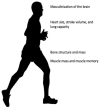Transwoman Elite Athletes: Their Extra Percentage Relative to Female Physiology
- PMID: 35897465
- PMCID: PMC9331831
- DOI: 10.3390/ijerph19159103
Transwoman Elite Athletes: Their Extra Percentage Relative to Female Physiology
Abstract
There is increasing debate as to whether transwoman athletes should be included in the elite female competition. Most elite sports are divided into male and female divisions because of the greater athletic performance displayed by males. Without the sex division, females would have little chance of winning because males are faster, stronger, and have greater endurance capacity. Male physiology underpins their better athletic performance including increased muscle mass and strength, stronger bones, different skeletal structure, better adapted cardiorespiratory systems, and early developmental effects on brain networks that wires males to be inherently more competitive and aggressive. Testosterone secreted before birth, postnatally, and then after puberty is the major factor that drives these physiological sex differences, and as adults, testosterone levels are ten to fifteen times higher in males than females. The non-overlapping ranges of testosterone between the sexes has led sports regulators, such as the International Olympic Committee, to use 10 nmol/L testosterone as a sole physiological parameter to divide the male and female sporting divisions. Using testosterone levels as a basis for separating female and male elite athletes is arguably flawed. Male physiology cannot be reformatted by estrogen therapy in transwoman athletes because testosterone has driven permanent effects through early life exposure. This descriptive critical review discusses the inherent male physiological advantages that lead to superior athletic performance and then addresses how estrogen therapy fails to create a female-like physiology in the male. Ultimately, the former male physiology of transwoman athletes provides them with a physiological advantage over the cis-female athlete.
Keywords: exercise physiology; hormone therapy; sex differences; testosterone; transgender.
Conflict of interest statement
The author declares no conflict of interest.
Figures

Similar articles
-
The International Olympic Committee framework on fairness, inclusion and nondiscrimination on the basis of gender identity and sex variations does not protect fairness for female athletes.Scand J Med Sci Sports. 2024 Mar;34(3):e14581. doi: 10.1111/sms.14581. Scand J Med Sci Sports. 2024. PMID: 38511417
-
The Biology of Sex and Sport.JBJS Rev. 2020 Mar;8(3):e0140. doi: 10.2106/JBJS.RVW.19.00140. JBJS Rev. 2020. PMID: 32224635 Review.
-
Effects of six weeks of sub-plateau cold environment training on physical functioning and athletic ability in elite parallel giant slalom snowboard athletes.PeerJ. 2023 Jan 26;11:e14770. doi: 10.7717/peerj.14770. eCollection 2023. PeerJ. 2023. PMID: 36721778 Free PMC article.
-
Circulating Testosterone as the Hormonal Basis of Sex Differences in Athletic Performance.Endocr Rev. 2018 Oct 1;39(5):803-829. doi: 10.1210/er.2018-00020. Endocr Rev. 2018. PMID: 30010735 Free PMC article. Review.
-
Is testosterone responsible for athletic success in female athletes?J Sports Med Phys Fitness. 2020 Oct;60(10):1377-1382. doi: 10.23736/S0022-4707.20.10171-3. Epub 2020 Jun 29. J Sports Med Phys Fitness. 2020. PMID: 32608215
Cited by
-
Sex Differences in Athletic Performance: Perspectives on Transgender Athletes.Exerc Sport Sci Rev. 2023 Jul 1;51(3):85-95. doi: 10.1249/JES.0000000000000317. Epub 2023 Apr 14. Exerc Sport Sci Rev. 2023. PMID: 37057897 Free PMC article.
-
Novel insights into athlete physical recovery concerning lactate metabolism, lactate clearance and fatigue monitoring: A comprehensive review.Front Physiol. 2025 Mar 25;16:1459717. doi: 10.3389/fphys.2025.1459717. eCollection 2025. Front Physiol. 2025. PMID: 40200988 Free PMC article. Review.
-
Sex differences and athletic performance. Where do trans individuals fit into sports and athletics based on current research?Front Sports Act Living. 2023 Oct 27;5:1224476. doi: 10.3389/fspor.2023.1224476. eCollection 2023. Front Sports Act Living. 2023. PMID: 37964771 Free PMC article. Review.
-
The role of androgens and global and tissue-specific androgen receptor expression on body composition, exercise adaptation, and performance.Biol Sex Differ. 2025 Apr 23;16(1):28. doi: 10.1186/s13293-025-00707-6. Biol Sex Differ. 2025. PMID: 40269952 Free PMC article. Review.
References
Publication types
MeSH terms
Substances
LinkOut - more resources
Full Text Sources

